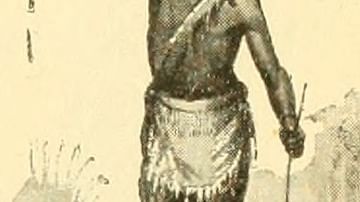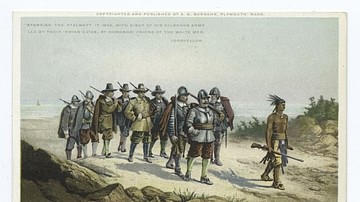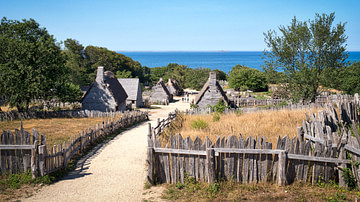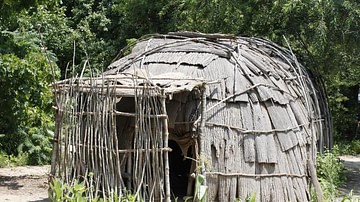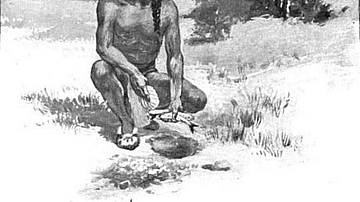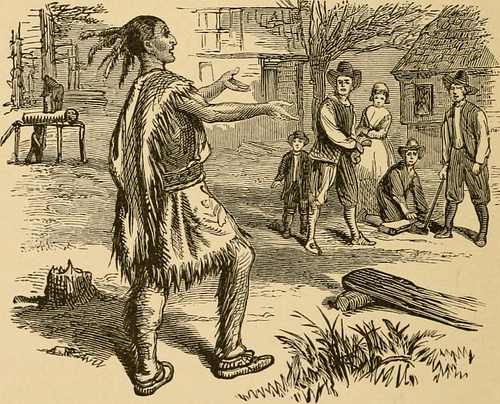
Samoset (l. c. 1590-1653, also given as Somerset) was the Abenaki Native American who first approached the English settlers of Plymouth Colony (later known as pilgrims) in friendship, introducing them to natives Squanto (l. c. 1585-1622) and Massasoit (l. c. 1581-1661) who would help save and sustain the colony.
He was a sagamore (chief) of the Eastern Abenaki, who was either visiting Massasoit or had been taken prisoner by him sometime before the Mayflower landed off the coast of modern-day Massachusetts in November 1620. Massasoit chose him to make first contact with the pilgrims in March of 1621, and he has been recognized since as instrumental in bringing the Native Americans of the Wampanoag Confederacy and English colonists of Plymouth together in a compact which would remain unbroken for the next 50 years.
Samoset's visit to Plymouth and the resultant peace treaty with the Wampanoag Confederacy under Massasoit is given in two of the primary documents of the early years of the settlement, Mourt's Relation, written by William Bradford (l. 1590-1657) and Edward Winslow (l. 1595-1655) and Of Plymouth Plantation by Bradford, though Samoset is also referenced by their contemporary Thomas Morton (l. c. 1579-1647) who provides the only report that he was a prisoner of Massasoit.
All that is known of Samoset comes from these works except for a passing mention by the explorer Captain Christopher Levett (l. 1586-1630), who met Samoset in 1624 at present-day Portland, Maine, and considered it an honor based on Samoset's role in helping to sustain Plymouth Colony in 1621. Later works either drew faithfully on these or departed from them to present Samoset as an “untrustworthy Indian” who only pretended friendship for personal gain or access to the colonists' women. The most notable example of this type of work is the 1808 melodrama The Pilgrims or The Landing of Our Forefathers at Plymouth Rock (author unknown) in which Samoset is cast as the villain attempting to abduct the virginal colonist Juliana. The play has no basis in reality, and Samoset, as Levett's report demonstrates, was highly regarded by other English and European colonists following his appearance in Mourt's Relation, published in 1622.
He is supposed to have died in 1653 in his home region of present-day Maine and is remembered for his part in the survival of the Plymouth Colony. He is regularly depicted in pageants and other commemorative events in the United States annually in November around the time of the holiday of Thanksgiving which draws inspiration from the Plymouth Colony's first harvest feast in the fall of 1621.
Native American & English Interaction Pre-1620
European explorers began visiting North America to map it shortly after Christopher Columbus (l. 1451-1506) established colonies for Spain in the Caribbean in 1492. In 1524, the Florentine seaman and explorer Giovanni da Verrazzano (l. 1485-1528) mapped the entire eastern seaboard of North America and provided the first map of the region later known as New England. The English came late to the colonization efforts, only finally establishing a successful colony at Jamestown, Virginia, in 1607.
English ships went up the coast, however, to explore trade possibilities in the north – between the regions claimed by France and the Netherlands – and established temporary settlements for fishing and hunting. Samoset would later tell the pilgrims he had learned English from these traders, knew the captains by name, and was on good terms with them, perhaps as a way of establishing trust with the newcomers.
Not every Nation of Native Americans in the region enjoyed this kind of relationship with the English, however. Native Americans who approached European ships at the invitation of trade were as often kidnapped and sold into slavery as dealt with honestly. The most famous example of this is the case of the Nauset sachem (chief) Epenow who was kidnapped by one Captain Harlow in 1610 from his native island of Capawe (modern-day Martha's Vineyard) and put on display as a “Wonder of the New World” for three years in London.
Epenow learned English while in captivity and let “slip” tantalizing tidbits regarding a gold mine on his old island which could make any man rich who cared to return. He was sent back to North America aboard a ship commanded by one Nicholas Hobson in 1614 to lead the crew to the mine. Once arrived, however, he leaped overboard, covered in his escape by a hail of arrows from members of his tribe in waiting canoes whom he had already prepared, and the ship sailed back for England with nothing in its hold.
Epenow became the primary source for information on the English, warning all the other natives of the region not to trust them until Squanto – who had also been kidnapped and taken to Europe – made his way back home in 1619. The Nauset tribe had experienced further outrages after Epenow had been taken as a number of them had been kidnapped by one Thomas Hunt in 1614.
Mayflower Arrival & First Encounter
By the time the Mayflower arrived in November of 1620, the friendly relations the Native Americans had initially offered 20 years before had been replaced by suspicion, fear, and outright hostility. Not only had the English regularly kidnapped men, women, and children but European diseases had wiped out large numbers from present-day Maine down through Massachusetts and to Virginia.
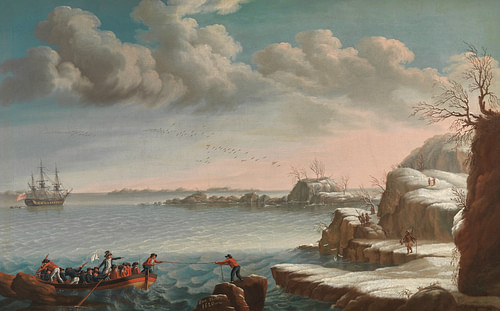
The pilgrims, at first, did nothing to improve relations as, lacking supplies, they stole corn and other provisions from the Nauset while they were exploring the area between November-December 1620. The Nauset responded by attacking a landing party in early December, an event recorded by Bradford as the First Encounter, in which no one on either side was injured, but the message the pilgrims received was that they should expect no help from the Native Americans.
Bradford and Winslow both note how, during the first winter of 1620-1621, the Native Americans were more felt than seen, “skulking about” in the woods surrounding the site where they were building their settlement. The Mayflower, with its cannon, remained anchored off the coast, and Captain Myles Standish (l. c. 1584-1656) built a stockade, so no further attacks were made but neither were there any overtures of friendship.
Massasoit's Decision
Between December 1620 and March 1621, 50% of the passengers and crew of the Mayflower died of disease, malnutrition, or other causes. They were supposed to have landed in Virginia and were unprepared for the harsh New England winter, and with so many of them sick, building the settlement progressed slowly. While the new arrivals struggled to survive, Massasoit considered what to do about them. Unlike the earlier ships, which had come, plundered, and left, this one had brought a group who clearly intended to stay. As he would later tell Bradford, his first impulse was to drive them from the land, and he tried to accomplish this through repeated powwows in which his chief shamans called on the spirits of the land for signs and assistance in his cause. The spirits did not respond, however, leading Massasoit to consider that they intended another purpose for the immigrants.
Massasoit was the leader of the vast Wampanoag Confederacy, a loose union of many different tribes, which had been the most powerful political and military force in the region before European diseases had killed many of them between c. 1610-1618. Massasoit had lost so many people that he was now subject to paying tribute to the more powerful Narragansett tribe who, living further inland, had not been affected by the plague.
Since the spirits had offered no help in driving off the immigrants, Massasoit seems to have reasoned, perhaps they had been sent to help him regain his former stature and put the Narragansett and Massachusetts tribe in their places. He needed an emissary, however, and had two likely candidates – Samoset and Squanto – who both spoke English and had experience with Europeans.
Squanto had been taken in by Massasoit in 1620 after he had returned with Captain Thomas Dermer in 1619. Dermer and his men were attacked (Dermer later dying from his wounds) while Squanto remained with Massasoit's tribe of the Pokanoket. He seems to have been regarded with suspicion by Massasoit as well as his right-hand man and chief warrior Hobbamock (d. c. 1643) and so Samoset was chosen to approach the colonists first.
Samoset's Visit
What Samoset was doing at Massasoit's village of Sowams in March 1621 is unclear. Bradford and Winslow both say that Samoset told them he came from the region of Morattiggon (modern-day Monhegan Island off the coast of Maine). Thomas Morton, the liberal lawyer and writer who would later become the enemy of the Plymouth Colony and include scathing critiques of their religious intolerance, hypocrisy, and colonization efforts in his New English Canaan (published c. 1637) claims he was a prisoner of Massasoit and agreed to undertake the mission in return for his freedom:
[Massasoit instructed] this savage how to behave himself in the treaty of peace and, the more to give him encouragement to adventure his person amongst these new-come inhabitants, which was a thing he durst not himself attempt without security or hostage, promised that savage freedom, who had been detained there as their captive; which offer he accepted and accordingly came to the Planters, saluting them with welcome in the English phrase. (Book III. ch. 1)
Bradford and Winslow make no mention of this but simply describe the first visit. Mourt's Relation, which predates Bradford's Of Plymouth Plantation both in composition and publication, gives the initial account:
Whilst we were busied hereabouts, we were interrupted again for there presented himself a savage, which caused an alarm. He very boldly came all alone and along the houses straight to the rendezvous [where weapons and cannon were], where we intercepted him, not suffering him to go in, as undoubtedly he would, out of his boldness. He saluted us in English and bade us welcome, for he had learned some broken English among the Englishmen that came to fish at Monchiggon and knew by name the most of the captains, commanders, and masters that usually come. He was a man free in speech, so far as he could express his mind, and of a seemly carriage. We questioned him of many things; he was the first savage we could meet withal. He said he was not of these parts but of Morattiggon, and one of the sagamores or lords thereof and had been eight months in these parts, it lying hence a day's sail with a great wind and five days by land. (51)
Samoset carried a bow with two arrows – one with a head (tip) and one without; symbols of either war or peace – one of which he seems to have been supposed to have left with the colonists. Bradford and Winslow describe him as tall, his hair cut short in the front but flowing long in the back, and naked except for a strip of leather around his waist and a fringe of animal hide, about nine inches long, falling from the strip at the front.
He told them all about the land they were in, how they were settled on the site of the former Patuxet tribe who had died of disease, and about Massasoit and the Wampanoag Confederacy. The colonists gave him food and liquor, and at one point when a cold wind began to blow, a coat. Bradford and Winslow note how “all afternoon we spent in communication with him; we would gladly have been rid of him at night, but he was not willing to go this night” (51-52). He was welcomed at the home of Stephen Hopkins (l. 1581-1644) who had previously lived at Jamestown and, through interaction with the Powhatan tribe of Virginia, knew a little of the Algonquian language Samoset spoke.

Samoset explained how the people of the region had come to distrust the English after Captain Hunt's abduction of them and that this was why the Nauset had attacked them in December. This was also, he explained, why the colonists' tools had recently been stolen – as a small act of revenge – and he agreed to negotiate for their return.
The next morning, they sent Samoset on his way with gifts of a knife, a bracelet, and a ring. He returned the next day, Sunday, with five warriors who came with skins to trade, but, it being the sabbath, the colonists said they could not work but would entertain them and provide them with food and drink. The five warriors then left, but Samoset, pretending he did not feel well enough to travel, remained at the settlement until Wednesday when he left with more gifts, telling them that Massasoit was coming, and the next day he returned with Squanto.
The Peace Treaty
Thursday, 22 March 1621, Samoset and Squanto explained how Massasoit was nearby with his warriors and his brother, Quadequina, and wanted to speak with them. Massasoit and his party then appeared on the nearby hill and Squanto went between the two groups telling the colonists that their leader should go speak with the chief. The governor at the time, John Carver (l. 1584-1621), refused, requesting Massasoit come to them, and Edward Winslow volunteered to go as a hostage while negotiations went on, bringing gifts of knives for Massasoit and Quadequina.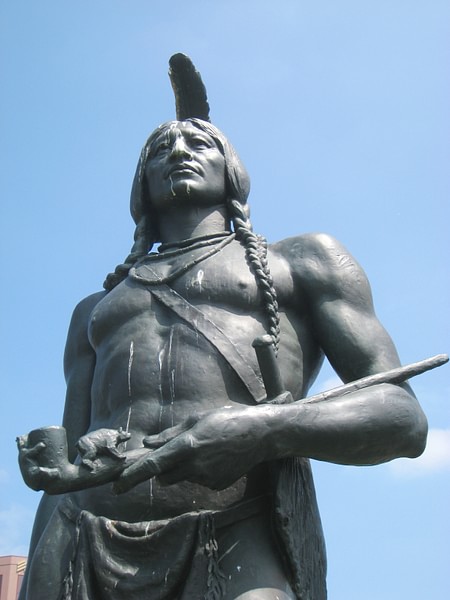
Massasoit was welcomed with all proper courtesy, including the sound of a trumpet and beating of drums and, after food and strong drink, a peace treaty was signed between the colonists and Massasoit to look out for each other's interests, maintain peaceful relations, and protect each other against enemies. Afterwards, Massasoit returned to his party, and Quadequina and his warriors came to be entertained for the rest of the day. At this point, Samoset leaves the narrative and is not referenced again as Squanto becomes the central Native American character.
The only other reference to him comes some years later when Captain Levett writes of a meeting with Native American sagamores in 1624 at the harbor of present-day Portland, Maine, to discuss trade. Levett writes:
There I stayed four nights, in which time, there came many native people, among them Somerset, a Sagamore, one that has been found very faithful to the English and has saved the lives of many of our nation, some from starving, others from killing. (Mack, 171)
Samoset's reputation, referenced by Levett, had to have grown from the account in Mourt's Relation which seems to have found an audience among the English whose interest in North America and colonization had grown immensely since the success of the tobacco crop of Jamestown. Mourt's Relation was brought back to England by Robert Cushman (l. 1577-1625) in 1621 and was published in 1622, and although Levett could have heard of Samoset by word of mouth, he most likely read of him in the account of Bradford and Winslow.
Conclusion
What happened to Samoset after he had arranged the meeting for the peace treaty is unknown as are any details of his later meeting with Levett. If he was a prisoner of Massasoit, then the chief kept his word and released him to return home. If he was only visiting, he must have thought his business concluded and left. He does not appear in any new light in the works of later writers, who only repeat what Bradford and Winslow wrote, until the 19th century when tales of the early colonization of North America became popular following the works of the American poet Henry Wadsworth Longfellow (l. 1807-1882) and novelist James Fenimore Cooper (l. 1789-1851) both of whom encouraged the vision of the Native American as “noble savage”, a term applied to both Samoset and Squanto.
The 1808 melodrama, The Pilgrims or the Landing of Our Forefathers at Plymouth Rock, departs from this image, casting Samoset as the villain. After Massasoit has left the colony following the signing of the peace treaty, Samoset tries to abduct the young woman Juliana in an act of treachery. Edward Winslow comes to her rescue but is wounded, dropping his musket, and Juliana, grabbing the weapon, flees for safety to some nearby cliffs. Samoset pursues her, but she strikes him with the butt of Winslow's musket, and he falls from the cliff to his death (Willison, 484).
How well the play was received is unknown, but it seems to be the only work which uses Samoset in this way. Since the publication of Mourt's Relation, and more so after Of Plymouth Plantation was published in 1856, he has always been regarded as the “friendly Indian” who brought the pilgrims and Native Americans together to forge their peace treaty. Since the early 20th century, Samoset is featured in plays and pageants annually in the United States in the weeks leading up to the holiday of Thanksgiving, though there is no evidence he was present in Plymouth Colony in the fall of 1621 when the First Thanksgiving is said to have been held, and he remains among the most enduring figures of early American history and lore.
